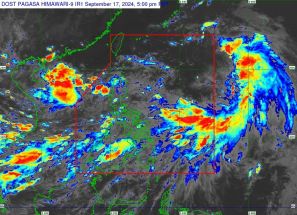Now 2-way

January 3, 2004 | 12:00am
As anticipated, the forthcoming electoral contest is quickly evolving from a 4-way race into what is effectively a 2-way contest. This is reflected in the quality and prominence of partisans joining the various presidential camps as the deadline for filing of candidacies nears.
Over the last few days, the two secondary presidential aspirants – Panfilo Lacson and Raul Roco – filed their candidacies. Lacson filed his candidacy without a running-mate. Roco, at the last minute, pulled Herminio Aquino out of the hat.
In what is considered a signal to the electorate, the principal contenders file their candidacies at the last hour. The nuisance candidates file first, the minor candidates go next and the main players come in last.
That is not merely ceremonial. There are reasons for that.
The major players wait to see the cards of their rivals and hold out to create the possibility for last-minute adjustments. The secondary players move ahead for a very practical reason: if they file at the same time as the major players, they will likely be snowed under by the crowds their rivals will bring to the filing, and disappear from the news the next day.
Bringing a horde of supporters to the Comelec to witness the moment of filing their certificates of candidacies is a necessity. It is necessary to project the image of mass support for a candidate. The filing of candidacies is a media event, a grand photo opportunity, and no candidate would want to appear sneaking into the Comelec offices by their lonesome, and almost surreptitiously.
And, if the lead candidates would have their way, they would rather come to file their certificates of candidacy with their entire slate. But some presidential contenders could not find enough candidates to fill up their vice presidential and senatorial line-ups. There simply are not enough politicians willing to stake their careers with a weak presidential bet.
This might seem unfair, but it is unavoidable: presidential contenders who do not come to the Comelec with a full and robust slate behind them are fixed in the public perception as ramshackle bids. If you want to be president, you must have at least a wide enough base of political supporters to effectively take a mammoth government by the reins in the event you win.
Panfilo Lacson coming to the Comelec with only one other candidate – Rep. Carlos Padilla who is aiming for a Senate seat – establishes him as an outside runner with a really long shot at the presidency.
Raul Roco coming in with a surprising – and obviously surprised – running-mate, along with a half-filled senatorial slate of half-serious contenders, becomes established in voter perception as the third placer.
And so the stage is set for a showdown between incumbent Gloria Macapagal Arroyo and actor Fernando Poe Jr.
The political forces are gathering around either contender. They are the recognized centers of gravity in the alliances forming for next May’s elections. They are the two poles of what is quickly developing into a battle between the forces that produced the Macapagal I, Aquino, Ramos and Macapagal II presidencies and those forces that evolved during the long Marcos period and aligned with the Estrada presidency the past few years.
As the looming head-to-head contest between GMA and FPJ gathers momentum, voter realignment is bound to happen. Support for secondary candidates Roco and Lacson is bound to dwindle. Financial support will inevitably realign.
What begins as a 4-way race quickly evolves into a 2-way race.
Over the last few days, GMA picked Sen. Noli de Castro as her running-mate. De Castro, broadcaster-turned-legislator, leads everyone else for that post in every survey taken.
Last Thursday, FPJ took Sen. Loren Legarda as his running-mate. Legarda, also a broadcaster-turned-politician, trails De Castro in voter preference surveys for the vice presidency.
By Monday, the deadline for the filing of national-level candidacies, both the Lakas-CMD and the NKP will have full slates for the senatorial contest. Both coalitions have a surfeit of winnable politicians aspiring for places in their senatorial tickets.
Although popularity, measured by the periodic voter preference surveys conducted by the various outfits, appears to be the single most important factor determining electoral outcomes, the importance of party organizations ought not to be understated.
There are prominent examples in the past – the cases of Mitra in 1992 and De Venecia in 1998 – that demonstrate that powerful party machineries can do nothing to make an unpopular candidate win. But there has been little discussion about how party machines have helped – even unpopular candidates.
A strong party machine propelled Eduardo Cojuangco to an impressive third-place finish in the 1992 elections despite the strong current in public opinion adverse to personalities associated with the Marcos presidency. Jose de Venecia, in the final May 1998 count, scored significantly higher than what the earlier voter preference polls indicated even as he lost miserably to the immensely popular Joseph Estrada.
True, in the past two presidential elections, voters split their votes and popular vice presidential bets Joseph Estrada and Gloria Macapagal Arroyo won while their respective standard-bearers lost. But it is also true that both losing standard-bearers – Cojuangco and De Venecia – turned in better-than-expected poll performances. Part of the reason for this has to be the popularity of their running-mates.
A strong party base of candidates cannot be unimportant to the final tallies of the presidential contenders. Local candidates, down to the level of councilors in the municipalities, have their core voting blocs. These blocs are expected to deliver a party vote going way up to the presidential candidate.
While the effectiveness of core party votes varies from situation to situation, it is obvious that a presidential candidate is better off with a large party with a complete slate down to the localities. A candidate without a fully developed and completely filled slate of minor candidacies relies entirely on popularity. That might not be enough to win.
Remember that the tremendously popular Estrada spent about P3 billion in his 1998 campaign nevertheless, according to former campaign insider Reli German. He also strung together an impressive array of local political lords ranging from Chavit Singson in the Ilocos, the Josons in Central Luzon, Duterte in Davao, Emano in Northern Mindanao and Hagedorn in Palawan. All these local lords are on GMA’s side.
Finally, the looming showdown between GMA and FPJ is not entirely a contest between popularity and party machine. An impressive, albeit aging, army of pro-Estrada politicians are lined up behind FPJ. And GMA is not starting out from a position of extreme unpopularity.
Over the last few days, the two secondary presidential aspirants – Panfilo Lacson and Raul Roco – filed their candidacies. Lacson filed his candidacy without a running-mate. Roco, at the last minute, pulled Herminio Aquino out of the hat.
In what is considered a signal to the electorate, the principal contenders file their candidacies at the last hour. The nuisance candidates file first, the minor candidates go next and the main players come in last.
That is not merely ceremonial. There are reasons for that.
The major players wait to see the cards of their rivals and hold out to create the possibility for last-minute adjustments. The secondary players move ahead for a very practical reason: if they file at the same time as the major players, they will likely be snowed under by the crowds their rivals will bring to the filing, and disappear from the news the next day.
Bringing a horde of supporters to the Comelec to witness the moment of filing their certificates of candidacies is a necessity. It is necessary to project the image of mass support for a candidate. The filing of candidacies is a media event, a grand photo opportunity, and no candidate would want to appear sneaking into the Comelec offices by their lonesome, and almost surreptitiously.
And, if the lead candidates would have their way, they would rather come to file their certificates of candidacy with their entire slate. But some presidential contenders could not find enough candidates to fill up their vice presidential and senatorial line-ups. There simply are not enough politicians willing to stake their careers with a weak presidential bet.
This might seem unfair, but it is unavoidable: presidential contenders who do not come to the Comelec with a full and robust slate behind them are fixed in the public perception as ramshackle bids. If you want to be president, you must have at least a wide enough base of political supporters to effectively take a mammoth government by the reins in the event you win.
Panfilo Lacson coming to the Comelec with only one other candidate – Rep. Carlos Padilla who is aiming for a Senate seat – establishes him as an outside runner with a really long shot at the presidency.
Raul Roco coming in with a surprising – and obviously surprised – running-mate, along with a half-filled senatorial slate of half-serious contenders, becomes established in voter perception as the third placer.
And so the stage is set for a showdown between incumbent Gloria Macapagal Arroyo and actor Fernando Poe Jr.
The political forces are gathering around either contender. They are the recognized centers of gravity in the alliances forming for next May’s elections. They are the two poles of what is quickly developing into a battle between the forces that produced the Macapagal I, Aquino, Ramos and Macapagal II presidencies and those forces that evolved during the long Marcos period and aligned with the Estrada presidency the past few years.
As the looming head-to-head contest between GMA and FPJ gathers momentum, voter realignment is bound to happen. Support for secondary candidates Roco and Lacson is bound to dwindle. Financial support will inevitably realign.
What begins as a 4-way race quickly evolves into a 2-way race.
Over the last few days, GMA picked Sen. Noli de Castro as her running-mate. De Castro, broadcaster-turned-legislator, leads everyone else for that post in every survey taken.
Last Thursday, FPJ took Sen. Loren Legarda as his running-mate. Legarda, also a broadcaster-turned-politician, trails De Castro in voter preference surveys for the vice presidency.
By Monday, the deadline for the filing of national-level candidacies, both the Lakas-CMD and the NKP will have full slates for the senatorial contest. Both coalitions have a surfeit of winnable politicians aspiring for places in their senatorial tickets.
Although popularity, measured by the periodic voter preference surveys conducted by the various outfits, appears to be the single most important factor determining electoral outcomes, the importance of party organizations ought not to be understated.
There are prominent examples in the past – the cases of Mitra in 1992 and De Venecia in 1998 – that demonstrate that powerful party machineries can do nothing to make an unpopular candidate win. But there has been little discussion about how party machines have helped – even unpopular candidates.
A strong party machine propelled Eduardo Cojuangco to an impressive third-place finish in the 1992 elections despite the strong current in public opinion adverse to personalities associated with the Marcos presidency. Jose de Venecia, in the final May 1998 count, scored significantly higher than what the earlier voter preference polls indicated even as he lost miserably to the immensely popular Joseph Estrada.
True, in the past two presidential elections, voters split their votes and popular vice presidential bets Joseph Estrada and Gloria Macapagal Arroyo won while their respective standard-bearers lost. But it is also true that both losing standard-bearers – Cojuangco and De Venecia – turned in better-than-expected poll performances. Part of the reason for this has to be the popularity of their running-mates.
A strong party base of candidates cannot be unimportant to the final tallies of the presidential contenders. Local candidates, down to the level of councilors in the municipalities, have their core voting blocs. These blocs are expected to deliver a party vote going way up to the presidential candidate.
While the effectiveness of core party votes varies from situation to situation, it is obvious that a presidential candidate is better off with a large party with a complete slate down to the localities. A candidate without a fully developed and completely filled slate of minor candidacies relies entirely on popularity. That might not be enough to win.
Remember that the tremendously popular Estrada spent about P3 billion in his 1998 campaign nevertheless, according to former campaign insider Reli German. He also strung together an impressive array of local political lords ranging from Chavit Singson in the Ilocos, the Josons in Central Luzon, Duterte in Davao, Emano in Northern Mindanao and Hagedorn in Palawan. All these local lords are on GMA’s side.
Finally, the looming showdown between GMA and FPJ is not entirely a contest between popularity and party machine. An impressive, albeit aging, army of pro-Estrada politicians are lined up behind FPJ. And GMA is not starting out from a position of extreme unpopularity.
BrandSpace Articles
<
>
- Latest
- Trending
Trending
Latest
Trending
Latest

By BAR NONE | By Ian Manticajon | 4 days ago

By PERSPECTIVE | By Cherry Ballescas | 4 days ago
Recommended




























